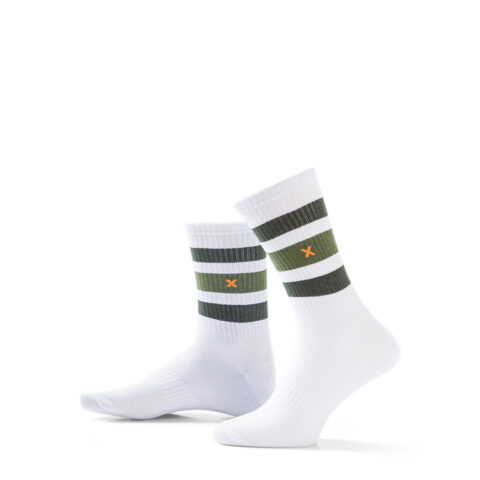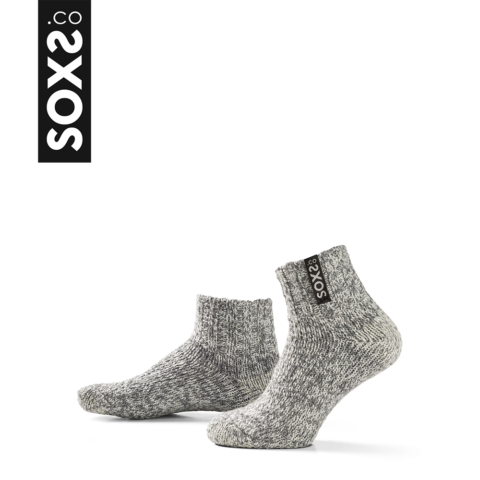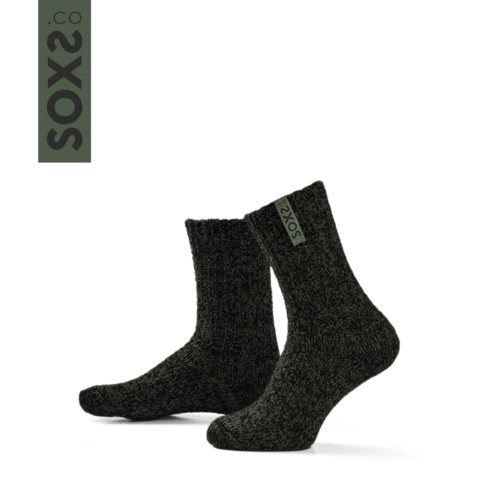Soft warm premium wool socks
Gift ready, stylishly packaged
Orders placed before 1:00 PM will be shipped today (on weekdays) PLEASE NOTE: The delivery time of Pimp My Soxs is 5 working days!
The material of your socks directly impacts your daily comfort, how long they last, and their environmental impact. Understanding the difference between wool and cotton helps you make better choices for your needs. Let’s explore what makes each material unique and why wool offers distinct advantages for your feet.
Wool and cotton stand as the most common natural fibers in sock production. Wool comes from sheep and provides natural elasticity and excellent insulation. This makes it particularly valuable for outdoor wool socks that keep feet comfortable across various weather conditions.
Cotton offers softness and breathability, making it a common choice for everyday wear. However, when performance matters in challenging conditions, wool typically performs better for your feet.
Wool socks excel at providing warmth during cold weather. The natural structure of wool creates tiny air pockets that trap heat effectively, keeping your feet warm even on winter walks. Your toes stay cozy whether you’re active outdoors or relaxing at home.
Cotton socks lose their insulating properties when they get damp, making them less effective in cold conditions. This is why wool is often preferred for activities where maintaining warmth is essential, from hiking to simply getting through a cold day.
One of wool’s most valuable features is its natural ability to manage moisture. Wool fibers absorb up to 30% of their weight in moisture while still feeling dry against your skin. This pulls sweat away and allows it to evaporate, keeping your feet dry during activities like running or yoga.
Cotton tends to hold onto moisture once it absorbs it. This can lead to damp, uncomfortable feet and potential blisters during physical activity. For active use, wool provides better performance by keeping your feet consistently dry.
Wool socks typically outlast cotton ones thanks to wool’s natural elasticity and resilience. While cotton tends to stretch and lose shape over time, wool maintains its form through many wears and washes. This durability makes wool socks a smart investment for your wardrobe.
The initial cost of wool socks may be higher, but their extended lifespan offers better value over time. Whether you’re looking for wool socks for kids or adults, you’ll appreciate how they maintain their quality with regular use.
Both materials offer distinct comfort benefits. Modern wool socks are designed to be completely itch-free, unlike traditional wool garments of the past. At SOXS, our wool socks provide exceptional softness without any scratchy feeling against your skin.
Cotton naturally feels soft and gentle, making it suitable for sensitive skin. However, today’s wool socks match this comfort while delivering superior performance, giving you the best of both worlds for your feet.
Wool offers significant environmental advantages as a renewable resource. Sheep naturally grow a new fleece each year, and we source our wool sustainably to create environmentally friendly socks you can feel good about wearing.
Cotton production typically requires substantial water and often pesticides, raising environmental concerns. By choosing our organic wool socks, you support more sustainable practices that align with conscious consumer values.
Skin comfort matters when selecting socks for daily wear. Modern wool processing has greatly reduced potential skin irritation issues. If you have sensitive skin, testing wool socks on a small area first can help determine if they work for you.
Cotton is generally hypoallergenic and works well for sensitive skin. Thanks to advances in wool processing, many people with sensitivities find they can comfortably wear quality wool socks without irritation.
Both wool and cotton socks come in various styles to complement your wardrobe. Wool socks offer rich colors and natural texture that work well with streetwear or as a cozy addition to your everyday outfits.
You’ll find a wide range of colors and patterns in both materials to match your personal style. Whether you prefer subtle designs or something more distinctive, wool provides versatile options that look good while performing better.
When considering value, look beyond the initial price. Wool socks typically cost more upfront but offer extended wear and superior performance. This makes them a worthwhile investment for everything from warm baby socks to durable walking socks.
Cotton socks cost less initially but usually need replacement sooner. The true value comes from how well the socks meet your specific needs for comfort, performance, and durability over time.
Your decision between wool and cotton depends on several factors including warmth needs, moisture management, durability, and comfort preferences. Wool delivers superior insulation, moisture control, and longevity, making it an excellent choice for quality-conscious consumers.
By understanding these differences, you can select socks that truly serve your lifestyle and values. For reliable warmth, all-day comfort, and sustainable materials, wool socks offer practical benefits that improve your daily experience.
Which activities would you like to try with a pair of comfortable wool socks? Discover our full collection at soxs.co.

Calf height

Ankle height

Calf height